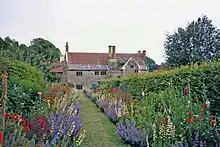John Seely, 2nd Baron Mottistone
Henry John Alexander Seely, 2nd Baron Mottistone (1 May 1899 – 18 January 1963) was an architect whose work in the partnership of Seely & Paget included the interior of Eltham Palace in the Art Deco style, and the post-World War II restoration of a number of bomb-damaged buildings, such as houses in the Little Cloister (Westminster Abbey), the London Charterhouse and the church of St John Clerkenwell.

Biography
Henry John Alexander Seely was born on 1 May 1899, the son of John Seely, 1st Baron Mottistone, a British Army general and politician, and Emily Florence, daughter of Colonel Honourable Sir Henry George Louis Crichton.[1]
He attended West Downs School, Winchester, an independent preparatory school, and then went to Harrow School and Trinity College, Cambridge where he read Architecture and met his future business partner, and life partner,[2] Paul Edward Paget, the son of the Bishop of Chester.[3]
He served during World War I. His elder brother, 2Lt Frank Reginald Seely of the Royal Hampshire Regiment, was killed in action at the Battle of Arras.[1]
After the War, he co-founded the architect firm of Seely & Paget. According to Paget, "it was just the marriage of two minds... we became virtually one person". They were inseparable in business and life, and referred to each other as "the partner". They lived and worked at 41 Cloth Fair, London, where the firm remained until 1986.[1][4]
.jpg.webp)
The partnership's works included the remodelling of Mottistone Manor, and the transformation of the medieval Eltham Palace, into an Art Deco mansion.[4]
John Seely served in the Auxiliary Air Force and at the Ministry of Works during World War II. He succeeded to the Mottistone barony in 1947.[1] After WWII Seely & Paget designed new churches including St Andrew and St George Stevenage, the largest parish church built in England since 1945,[4] and restored many buildings after war damage including Lambeth Palace and Eton College, and many London churches.[1][5]
In 1947 John Seely was Surveyor of the Fabric of St Paul's Cathedral and designed the Chapel of the Order of the British Empire, at the eastern end of the crypt.[6] He was also appointed architect to St George's chapel, Windsor Castle and Lay Canon and architect at Portsmouth Cathedral.[1] He was awarded OBE in the 1961 New Year Honours.[7] The National Portrait Gallery, London holds six portraits of him in its collection, by photographers Walter Stoneman and Elliott & Fry.[8]
He died without issue on 18 January 1963 and was accordingly succeeded by his brother, Arthur Patrick William Seely, 3rd Baron Mottistone. He is buried in St Catherine's chapel garden at Westminster Abbey.[1] In a niche in the wall of one of the houses in the Little Cloister, which Lord Mottistone restored, there is a statue of St Catherine by Edwin Russell that is a memorial to him. The inscription reads "John Mottistone. This is a sign of love and sadness. P.E.P. 1966 A.C.D." P.E.P stands for Paul Edward Paget, Lord Mottistone's partner. A.C.D. is Alan Campbell Don, the Dean of Westminster at the time of Lord Mottistone's death.[1]
|
References
- "John Seely, Lord Mottistone". Westminster Abbey. Retrieved 11 January 2018.
- ‘The Partners: Seely and Paget’, English Heritage. Web resource accessed 8 July 2019
- "The Shack, a country retreat". National Trust. Retrieved 11 January 2018.
- "Seely and Paget at Eltham Palace". English Heritage. Retrieved 11 January 2018.
- "John Seely – Lord Mottistone". Furzedown. Retrieved 11 January 2018.
- Harris, Brian L. (1988), Harris's Guide to Churches and Cathedrals, Ebury Press, ISBN 0091912512, pp=214–15
- "No. 42231". The London Gazette (Supplement). 27 December 1960. p. 8901.
- "John Seely, 2nd Baron Mottistone - Person - National Portrait Gallery". National Portrait Gallery. Retrieved 17 November 2020.
- Burke's Peerage. 1959.
| Peerage of the United Kingdom | ||
|---|---|---|
| Preceded by John Seely |
Baron Mottistone 1947–1963 |
Succeeded by Patrick Seely |